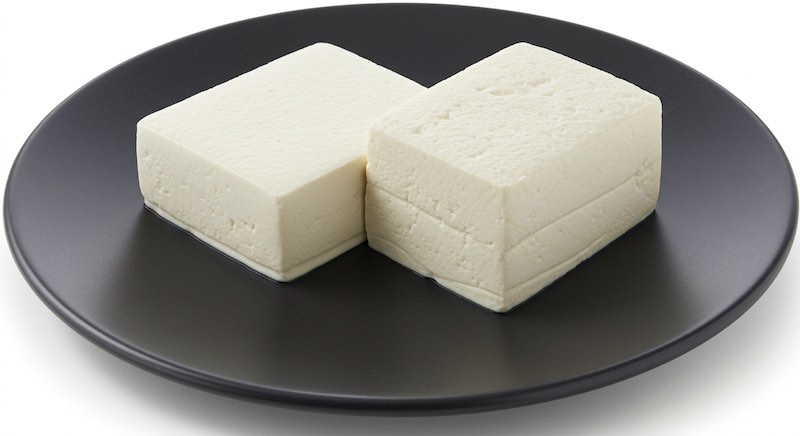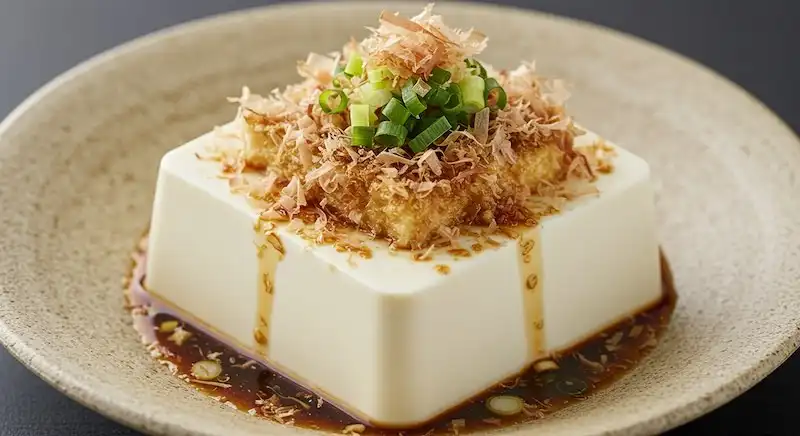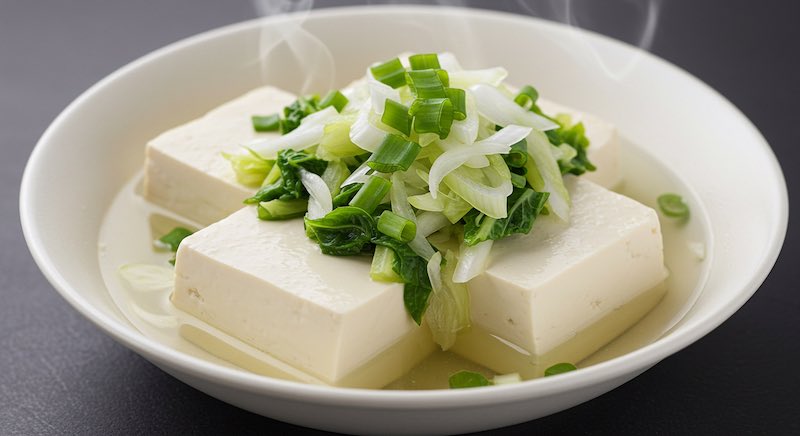A Powerhouse of Nutrition, Health, and Delicious Ways to Eat It
That square, white block you see in the supermarket – tofu.
It often appears on our dinner tables, but perhaps you’ve thought, “It’s a bit plain,” or “I only use it in certain dishes.”
But what if this humble-looking food holds many secrets to health and deliciousness?
Table of Contents
This time, let’s delve into the lesser-known appeal of “tofu,” an essential part of the Japanese diet.
From its surprising nutritional power and deep connection to Japanese health to delicious ways to enjoy it that will make your daily meals more exciting, let’s explore the world of tofu together!
A Japanese Table Staple, Yet a Superfood? The Deep History of Tofu
Tracing the roots of tofu takes us back a long way, with one theory suggesting it was invented around 2000 years ago in China during the Han Dynasty by Liu An, the King of Huainan.
The word “tofu” first appears in official records in the Chinese text “Qingyi Lu” from 965 AD.
It is widely believed that tofu was introduced to Japan between the Nara and Heian periods by Buddhist monks who traveled to Tang Dynasty China, bringing back Buddhism and other cultural aspects.
Initially, it was a special food reserved for a limited few, such as temple monks and aristocrats.
Tofu began to spread to the tables of common people in the Edo period, after the Muromachi period.
During this time, various dishes using tofu were developed.
A testament to its popularity is the recipe book “Tofu Hyakuchin” (100 Tofu Dishes), published in 1782. It remarkably introduced 100 different tofu recipes and became a major bestseller of its time.
The fact that sequels and supplementary volumes were published speaks volumes about how much tofu was loved by the people of Edo and how its culinary versatility was recognized early on.
Thus, tofu is not just a simple ingredient but an entity deeply rooted in Japanese food culture throughout its long history, evolving with the times.
Introduced from China initially as a special food, it eventually became a daily staple for commoners, and its value was recognized to the extent that a hundred different cooking methods were devised.
This background likely explains why tofu continues to be loved as a “health food” and “versatile ingredient” today.
Its nutritional value and its ability to blend with any flavor profile played a significant role.
Firm vs. Silken: Which is Your Preference? Differences in Texture, Taste, and Best Uses
Did you know there are mainly two types of tofu: “Momen” (Firm or Cotton) and “Kinugoshi” (Silken)? What are the differences between these two?
The Secret is in the Making!
The basic method for making tofu involves soaking soybeans in water, grinding them, heating to separate soy milk from okara (soy pulp), and adding a coagulant (like nigari) to solidify the soy milk.
The difference between Firm and Silken tofu lies in this “solidifying process.”
- Firm Tofu (Momen)
Soy milk with a coagulant is solidified once, then broken up, placed in a mold lined with cloth (traditionally cotton, hence the name), and pressed with a weight to squeeze out excess water.
Removing the water gives it a firm, somewhat coarse texture. - Silken Tofu (Kinugoshi)
A thicker soy milk with a coagulant is mixed and poured directly into a mold to solidify.
It’s not broken up or pressed to remove water like Firm tofu. This results in a fine, smooth, and soft texture.
How to Use Them in Cooking?
This difference in manufacturing method is key to determining the best uses for each type of tofu.
- Firm Tofu
With less water and a firm structure, it holds its shape well when heated.
It’s ideal for stir-fries (like Goya Champuru), stews, tofu steaks, and even crumbling into dishes like “tofu burgers” or using as a meat substitute.
It also absorbs flavors well. - Silken Tofu
Best suited for dishes where its smooth texture can be enjoyed.
Perfect for Cold Tofu (Hiyayakko) and Hot Pot Tofu (Yudofu), as well as ingredients in miso soup, smoothies, desserts, or anything where you want a silky texture.

The difference in production also subtly affects nutrition.
In Firm tofu, the water is pressed out, concentrating the soy components.
Silken tofu retains more water, meaning water-soluble nutrients are more likely to remain.
This variation in texture and composition makes choosing between the two types an interesting aspect of cooking with tofu.
A Deep Dive into Tofu’s Nutrition! More Than Just Protein – Its Hidden Strengths
You know tofu is healthy, but what specific nutrients does it contain?
In fact, tofu is a true “nutritional treasure trove,” packed with many essential nutrients beyond just protein.
A Prime Source of High-Quality Plant-Based Protein
First and foremost, let’s highlight the high-quality protein derived from soybeans, often called the “meat of the field.”
The protein in tofu contains essential amino acids that our bodies cannot produce, in well-balanced proportions.
Its quality is said to be comparable to animal protein from meat and fish (with an Amino Acid Score of 100).
Being plant-based while offering such high-quality protein readily is a major advantage.
Firm tofu contains about 7.0g of protein per 100g, while Silken tofu contains about 5.3g.
This difference is because the components are more concentrated in Firm tofu due to the water removal process.
For information on natto, which is also made from soybeans, click here: Natto: Japan’s Unsung Superfood for Health
Supports Bone Health! Also Rich in Calcium
Tofu is also rich in calcium.
Firm tofu, in particular, contains about 93mg per 100g (Silken tofu has about 75mg).
Some sources may list higher calcium amounts for Firm tofu, which can vary depending on the type of coagulant used.
Calcium is a major component of bones and teeth and is essential for maintaining health.
Furthermore, it contains minerals such as iron (Firm approx. 1.5mg, Silken approx. 1.2mg), magnesium, phosphorus, zinc, copper, manganese, and molybdenum.
An Ally for Dieting! Low in Calories & Carbs
Tofu is also recommended for those mindful of calorie intake.
The energy content per 100g is relatively low: about 73kcal for Firm tofu and about 56kcal for Silken tofu.
Silken tofu is an easier choice when you want to keep calories down.
For reference, a block of Firm tofu (approx. 300g) has about 219kcal, which is roughly the same as one bowl of rice (approx. 234kcal).
Additionally, it is characterized by a very low amount of carbohydrates and sugars.
Still More! Other Notable Nutrients
Besides these, tofu contains various other nutrients:
- Vitamins
Includes B vitamins (B1, niacin, biotin, folate, etc.), Vitamin K, and Vitamin E.
Due to the different production methods, Silken tofu tends to have slightly more Vitamin B1 and potassium, while Firm tofu may have slightly more niacin and biotin.
Vitamin K is crucial for blood clotting and bone health and is particularly abundant in Silken tofu. - Healthy Fats
Tofu’s fats are mainly unsaturated fatty acids like n-3 fatty acids (alpha-linolenic acid) and n-6 fatty acids (linoleic acid). - Lecithin & Saponins
Contains lecithin, a component of cell membranes, and saponins, which are compounds with potential antioxidant effects, among others.
As you can see, tofu is not just a protein source but a versatile player containing a balanced range of nutrients, including minerals, vitamins, and healthy fats.
It can serve as a general nutritional supplement, not just a protein source.
For other superfoods click here: 5 Japanese Superfoods Regularly Consumed by Japanese People
Firm vs. Silken Nutritional Comparison (per 100g)
| Nutrient | Firm Tofu (Momen) | Silken Tofu (Kinu) |
| Energy (kcal) | 73 | 56 |
| Protein (g) | 7.0 | 5.3 |
| Fat (g) | 4.9 | 3.5 |
| Carbohydrates (g) | 1.5 | 2.0 |
| Calcium (mg) | 93 | 75 |
| Iron (mg) | 1.5 | 1.2 |
| Potassium (mg) | 110 | 150 |
| Vitamin K (µg) | 6 | 9 |
Source: MEXT (Japanese Ministry of Education, Culture, Sports, Science and Technology) – Standard Tables of Food Composition in Japan
Tofu Power for Health! The Secret Behind Japanese Vitality and Longevity?
One reason traditional Japanese cuisine is considered healthy is the consumption of soy products, including tofu.
Let’s explore the potential ways tofu supports our health.
Potential for Preventing Lifestyle-Related Diseases
Research suggests that consuming soybeans and tofu may help lower blood cholesterol, particularly LDL (bad) cholesterol.
Furthermore, large-scale follow-up studies have observed a trend where people who frequently consume soy products have a lower risk of Type 2 diabetes, possibly because components in soybeans help insulin function.
The Noteworthy Component: “Soy Isoflavones”
A particularly significant component found in tofu and other soy products is “soy isoflavones.”
These are a type of plant compound (phytoestrogen) with a structure similar to the female hormone estrogen.
These isoflavones are expected to offer various health benefits:
- Easing Menopause Symptoms
Due to their estrogen-like effects, they are pointed to as potentially alleviating uncomfortable symptoms during menopause, such as hot flashes. - Maintaining Bone Health
Particularly for postmenopausal women who are prone to weaker bones due to decreased estrogen, studies suggest that isoflavones might help calcium deposit in bones, potentially aiding in the prevention of osteoporosis. - Potential Cancer Prevention
Some studies indicate that individuals with higher intakes of soy products and isoflavones tend to have a lower risk of certain cancers, including breast cancer (especially postmenopausal), prostate cancer, stomach cancer, and colorectal cancer.
Click here for more information: Japanese Association of Preventive Medicine for Lifestyle-related Diseases
Importance of “Balance” and “Getting from Food”
However, research on the effects of isoflavones is ongoing, and results can sometimes be inconsistent.
For example, regarding their link to cognitive function, some reports suggest a higher risk with increased intake, while others show improvement, so it’s not yet definitive.
It’s crucial to understand that these observed health effects are largely based on the traditional Japanese diet, where people have regularly and balancedly consumed “traditional soy foods” like tofu, natto (fermented soybeans), and miso (soy paste).
The average daily intake of soy isoflavones in Japan is reported to be around 16-22mg.
Half a block of tofu (150g) contains approximately 40mg of isoflavones.
On the other hand, caution is advised regarding consuming large amounts of isolated components from supplements.
The Japanese Ministry of Health, Labour and Welfare (MHLW), among others, has set upper limits for isoflavone intake when supplementing (a safe daily upper intake guideline is 70-75mg, with desirable supplemental intake capped at 30mg per day; excessive intake is not recommended).
See the MHLW guidelines for details: Isoflavone Guidelines
This means the secret to maximizing tofu’s health power is not relying on supplements but incorporating tofu and other soy products into your daily meals in a balanced and enjoyable way.
The health benefits seen in the traditional diet may stem not just from single components but from the combination of foods and the overall dietary pattern.
From Classics to Creative Dishes! Delicious Ways to Enjoy Tofu More
Tofu is nutritious and healthy.
Knowing how to maximize its appeal can make your daily meals much richer.
Here, we introduce delicious ways to enjoy tofu, from classic preparations to slightly unexpected arrangements.
Simple is Best! Mastering the Classics: “Cold Tofu” and “Hot Pot Tofu”
Cold Tofu (Hiyayakko)
Savoring Tofu’s Pure Taste A summer staple, Cold Tofu.
Precisely because it’s simple, a few small tips can make it exceptionally delicious.
Hiyayakko is a typical dish at izakayas, but here are some other typical dishes: 10 Must-Try Izakaya Dishes in Japan

- Choosing Tofu
Silken tofu is the classic choice for its smooth texture, but Firm tofu is also delicious.
The taste of the tofu itself is key, so try to find your favorite. - Temperature is Key
Actually, chilled tofu straight from the refrigerator might be too cold.
Letting it warm slightly to room temperature (around 16℃-18℃ or 60-65°F) allows you to better appreciate the sweetness and umami of the soybeans.
Taking it out of the fridge 20-30 minutes before eating is recommended. - Toppings and Sauce
Classic toppings include grated ginger, chopped green onions (soaking them in water removes some of the pungency), and bonito flakes (katsuobushi).
For the sauce, good quality soy sauce alone, or mixed with a little dashi (broth) or sake, won’t overpower the tofu’s delicate flavor.
Enjoying it with ponzu (citrus-based sauce) or simply with wasabi and salt is also refined.
Adding soy sauce just before eating is a tip to prevent the tofu from releasing too much water.
- Learn more about wasabi here: Discover Wasabi: Unlocking the Secrets of Real it
Hot Pot Tofu (Yudofu)
A Gentle, Warming Dish for Body and Soul Hot Pot Tofu is a welcome dish in the cold season.
Warm, soft tofu is exceptional.

- Choosing Tofu
Silken tofu is popular for its smooth texture, but Firm tofu is also delicious. - Gentle Heating
The key to Yudofu is not to boil the tofu vigorously.
Fierce boiling will cause small holes (“su”) to form in the tofu, making it tough.
The trick is to gently warm it in water (or hot water) with kelp (konbu).
The umami from the kelp transfers to the tofu, making it delicious.
Using an earthenware pot helps maintain a stable temperature.
The ideal temperature is around 90℃ (about 194°F). - Sauce and Toppings
Enjoy the warm tofu with a ponzu or soy sauce-based dipping sauce.
Grated radish (daikon oroshi), grated ginger, chopped green onions, and shichimi (Japanese seven-spice blend) pair well as toppings.
The Infinite Possibilities of Tofu! Modern Ways to Enjoy It
Tofu’s versatility extends beyond Japanese cuisine.
As the Star of Healthy Side Dishes
“Tofu burgers,” made by mixing crumbled Firm tofu with ground meat (or using tofu entirely), are soft, fluffy, and lower in calories.
It’s also great in stir-fries and as a steak.
Unexpected Transformation into Sweets
Tofu’s smooth texture is also a great asset in making desserts! It’s used in puddings, mousses, cheesecake-style dishes, smoothies, and even baked goods like donuts and pound cakes.
Simply topping tofu with black sugar syrup (kuromitsu) and roasted soybean flour (kinako) makes a lovely Japanese sweet.
Easy Arrangement: “Tofu Dip”
Just blend Silken tofu (no need to drain water) with lemon juice, grated garlic, your favorite herbs (like dill or chives), salt, and pepper until smooth using a food processor or blender.
Serve with vegetable sticks or crackers.
A Little Detour: Unique Regional Tofus
In different parts of Japan, there are unique local tofus.
If you encounter them on your travels, be sure to give them a try!
- Okinawan Tofu
- Yushi Tofu: Tofu in its soft, fluffy, pre-molded state.
Typically eaten in soups or simply with toppings and soy sauce. - Jimami Tofu: Surprisingly made from peanuts, this tofu has a chewy, mochi-like texture.
It’s enjoyed as a dessert or snack with a sweet sauce or soy sauce.
- Yushi Tofu: Tofu in its soft, fluffy, pre-molded state.
- Koya Tofu (Freeze-dried Tofu)
Tofu that has been frozen and then dried.
It has a unique texture and absorbs broth wonderfully when simmered.
It’s also characterized by its concentrated nutrients.
The charm of tofu lies in its ability to transform due to its mildness.
In simple dishes like Cold Tofu and Hot Pot Tofu, you can appreciate the delicate flavor of the tofu itself, while it also blends beautifully into burgers, sweets, and international dishes.
As the creation of “Tofu Hyakuchin” shows, people have long recognized its potential and devised various creative uses.
This “unassuming” individuality may be why tofu is loved across times and borders.
Make Tofu More Accessible, More Delicious!
How was that? We hope you’ve discovered that tofu, which you might usually eat without much thought, actually has a long history, surprising nutritional power, and is a versatile superfood.
Knowing the differences in personality and nutrition between Firm and Silken tofu makes choosing the right one for your cooking more fun. And let’s not forget that tofu is a reliable friend that supports our health in many ways, not just with protein and calcium.
Components like soy isoflavones, in particular, can offer benefits when incorporated well into a traditional dietary pattern.
Beyond classic ways like Cold Tofu and Hot Pot Tofu, please try new ways to enjoy tofu, such as tofu burgers, tofu sweets, and international tofu dishes.
Tofu is an affordable, health-supporting, and above all, delicious ingredient that fits perfectly into a modern diet.
Starting today, why not rediscover the charm of tofu and incorporate it more into your daily meals? It will surely make your diet richer and healthier.

Leave a Reply